It's been said that waterskiing is both art and science - blending the body's strength and agility into fluid motion in a way that few other sports do. Nuanced changes in balance along with practiced and controlled movement of feet, knees, and ankles can create beautifully arced turns and jumps, while measured body movements are magnified into acrobatic feats.
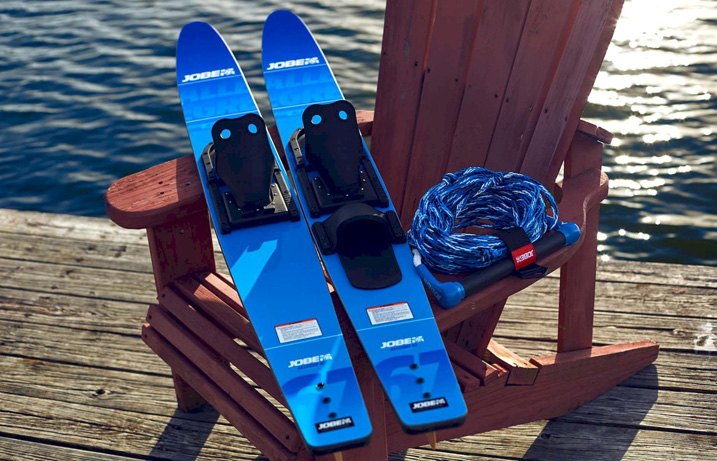
In addition to being one of the purest forms of enjoyment, water skiing is also great resistance training that builds core muscles in lower and upper body areas. A stronger core does wonders for keeping skeletal vertebrae aligned - improving posture and preventing back pain. And while strengthened legs, arms, shoulder, and torso areas look great, they also create stronger bones underneath.
Chances are if you're reading this, you already understand these concepts. What we're focusing on here in this article are waterskis we offer on our website as well as general tips for selecting a set that's best for you.
Waterski Dimensions & Characteristics
Length and Width
Waterskis that are wider in the front will displace more water - a factor that makes it easier to stand up initially and maintain stability at lower speeds. Wider-tip waterskis are benefical for beginners and intermediates for these reasons, and you'll find training skis are generally the widest (more on training skis further below). Experienced skiers may appreciate how wide tips make it easier to jump wakes.
When it comes to choosing waterski length, longer and narrower skis are better suited to faster speeds and expert-level maneuvers. Throughout this article, we touch on various length guidelines based on body weight and intended uses. Note that these are general references, and should not be used in place of any specific recommendations made by individual waterski manufacturers.
Edges
Edges that are sharp and squared-off cause a ski to sit higher on the water as you move, which adds to overall stability. Rounded edges cause the ski to drop down in the water, which allows more control as you're turning - especially at higher speeds.
Rocker
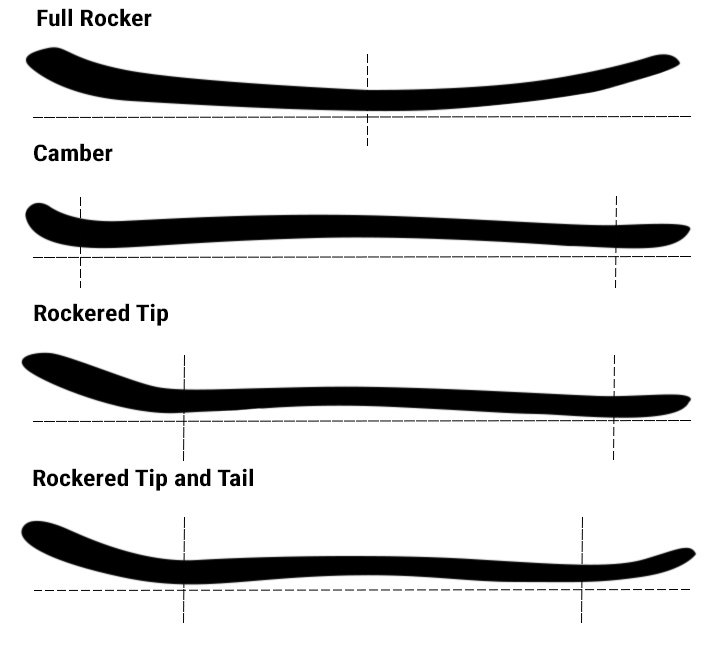
You'll come across the term "rocker" when reading about water skis. This describes the amount of curvature they have from front to back. To visualize what rocker is, imagine the overall shape of a curved rocking chair leg. Skis with more rocker curvature make it easier to turn, but they also increase drag. Conversely, skis with less rocker produce lower drag at speed and are more predictable. To combine and enhance both turning and stability, most waterskis feature flat spots in the middle with rocker dialed in at the ends, mostly in the front (these are also described as slalom toe waterskis).
Tunnels

Waterskis often feature "tunnel" shapes along their undersides to direct water in a variety of ways. Flat areas in front help when you're putting your weight there to stand up.

Narrower tunnel shapes with larger the flat spots along the edges help create a ski that's more directionally stable, especially in rougher waters. Slalom skis designed for performance typically have edge-to-edge concave shapes which create less drag and perform well when you're using the edges of the skis to turn in a more extreme fashion.
Trainer Skis
Because nobody's born knowing how to waterski, we'll start with trainer skis for beginners. These are wide, short in length, and flat along the bottom - factors which make all aspects of waterskiing easier for those learning.
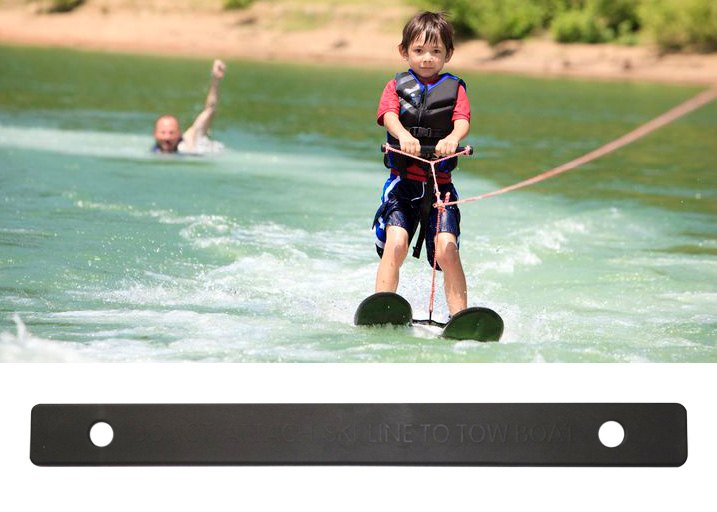
A "stabilizer bar" will typically be included with skis for beginners. These attach to left and right skis to keep them locked together as a new rider learns how to stay balanced. Stabilizer bars can also be attached to the boat's tow rope handle so that they're pulled along equally with the rider, and so they don't scatter during falls.

When it comes to training skis for smaller children, we've got good values with the Jobe Buzz Kid's Wood Trainers Water Skis (46", sizes 3-6), Nash Sports Hydroslide Kid's Sea Rover Trainers Waterskis (48", wood construction, 50-90 lb riders), and Airhead Monsta Splash Trainer Waterskis (48", riders up to 100 lbs, sizes child 12-adult 5). If you prefer trainers with a wider front area for easier stand-ups, there's the Jobe Hemi Kid's 46" Trainer Water Skis (46", sizes 3-6), Airhead Breakthru Widebody Trainers Waterskis (47"), and Nash Sports Hydroslide Kid's School Widebody Trainer Waterskis (48", 50-90 lb riders).

We've also got larger trainer skis with wider-than-average fronts such as the Airhead Wide Body Water Skis (54", sizes 2-9), Kent Full Throttle Shaped Kid's 54" Trainer Waterskis (54", sizes 2-7, up to 120 lbs), and Nash Sports Hydroslide Kids Wide Track Jr 54" Waterskis (54", riders up to 120 lbs).
Combination "Combo" Skis
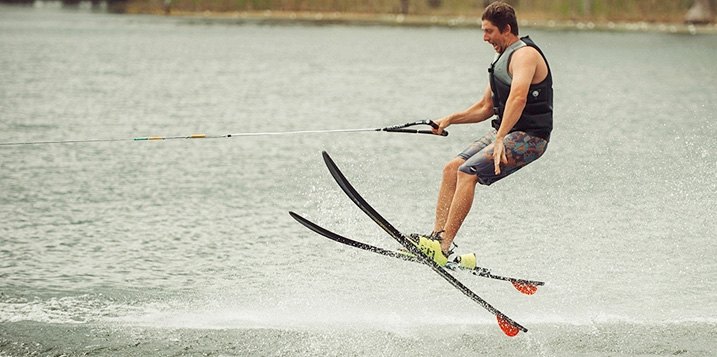
This is probably the most popular category of water skis because they embody a mix of characteristics from shaped skis (see below) and slalom style skis (further below) - making them ideal for riders of many skill levels. While lengths of combo skis can vary, they're usually wider than slalom skis but not as wide as shaped or trainer skis. Combos do become narrower toward the rear, but they don't taper as drastically.
Note that longer-length combo skis tend to embody dimensions of narrow slalom type skis meant for higher speeds. Horizontal surfaces on combo skis, however, may be flatter without as much rocker. In other cases, the only practical difference between the two types is the fact that slalom waterskis are technically sold as one ski only, while combos are sold in pairs.
With combo skis, one ski in the pair is equipped with two bindings should the rider choose to go slalom style with both feet on one ski.

Riders under 120 pounds who have grown out of trainer skis can graduate to combos that are under 60 inches in length. Less experienced riders over 120 pounds should stick to 64" or 65" skis, while experts over 120 pounds can go with 67" combo skis.
We've got the Airhead Wide Body Combo Skis (65", sizes 5-12) and Jobe Hemi Combo Waterskis (choose 59" or 65" lengths in sizes 6-14) with wider tips and less tapered rears. The Airhead Combo Water Skis (67", sizes 5-12) are designed to provide stability, control, and smooth tracking in turns for a range of skill levels thanks to a wider tail area and tunnel-shaped bottoms.
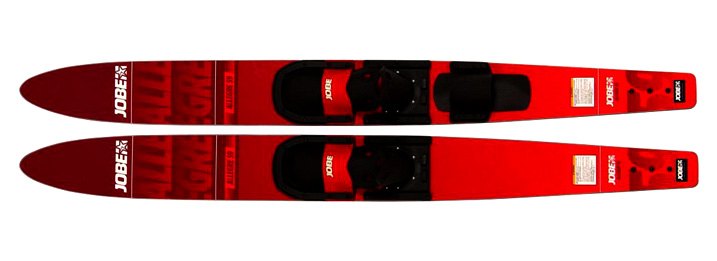
Additionally, Jobe offers their Allegre Combo Waterskis with adjustable bindings that can switch styles between combo skiing and entry-level slaloming in 59" and 67" lengths. Jobe's Mode Combo 67" Waterskis (67", sizes 6-14) taper off more in the rear and feature a V-shaped bottom for easy edge-to-edge and better tracking. The Nash Sports Legend Deluxe Water Skis (67", 120+ pound riders) feature a more tapered tail design that allows quick and aggressive turns.
Shaped Skis

Shaped skis are essentially combo skis with a distinct amount of extra width at the front to give the beginner or intermediate-level water skier easier start-ups and a more predictable ride. Shaped skis sometimes feature "side cuts", which means the width of the ski narrows around the binding areas to aid in turning. Because of their greater width, shaped skis are typically about 3-5 inches shorter than skis meant for high speed or slalom use (see below).
While shaped skis such as the Nash Sports Hydroslide Wide Track Shaped Combo Waterskis (64", 120+ pounds) are sold in pairs, only one of the skis has two bindings on it. This allows a skier to start off with two skis, then drop one in order to get both feet secured to a single ski for "slalom" type skiing.
What Is Slalom Waterskiing?
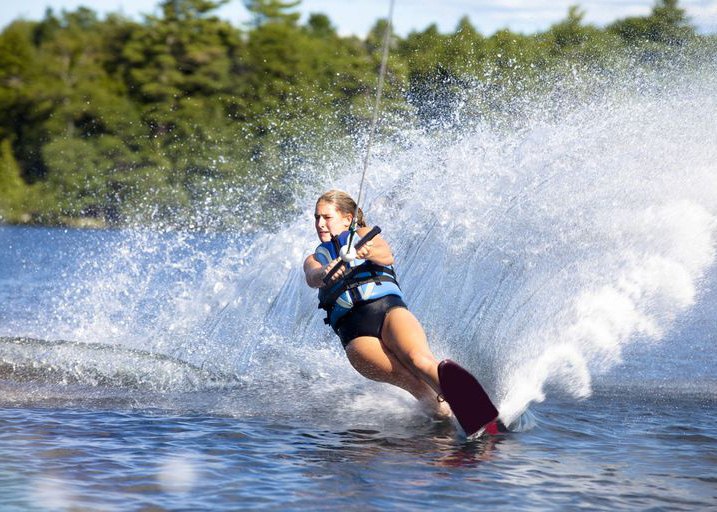
Slalom skiing is the act of skiing with both feet on a single ski. While the term is associated with fast, expert-level activity, "slalom skiing" can technically be done on any type of single ski you can get both feet onto.
In general, waterskis meant for slalom use are longer and narrower to create less drag at higher speeds. Narrow tail shapes make it easier for an experienced skier to slow down and turn sharply - something that's highly beneficial when darting between floating buoys in a "slalom" course.
Because we only sell waterskis in pairs, we've opted not to label any on our site as slalom skis, which are sold individually by themselves. As we mentioned earlier, some of the longer-length combo skis we sell are well suited to slalom skiing.

When choosing a waterski for slalom use, it's very important to base the length on body weight and how fast you plan on going. Buyers often make the mistake of selecting too short a slalom ski for their weight, which makes it tougher to stand up.
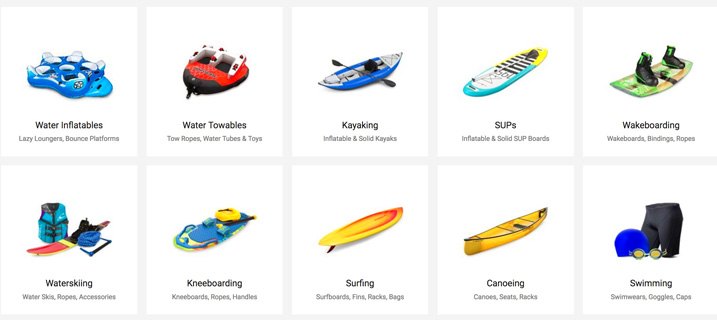
This concludes our overview of waterskis. In our water sports equipment section, you'll also find related equipment such as tow ropes and other accessories such as tow hooks, stabilizer bars, floatation belts, waterski holding racks, and more. Plus, we've also got other watersports essentials such as wakeboards, knee boards, towable rafts/tubes, and more.
We also encourage you to check through other sections of RECREATIONiD where you'll find some great remote control toys as well as products for climbing, camping & hiking, fishing, optical equipment, winter sports, helpful equipment for pets, and much more. If you have questions about anything on our website, we'll be happy to help on the phone seven days a week!
